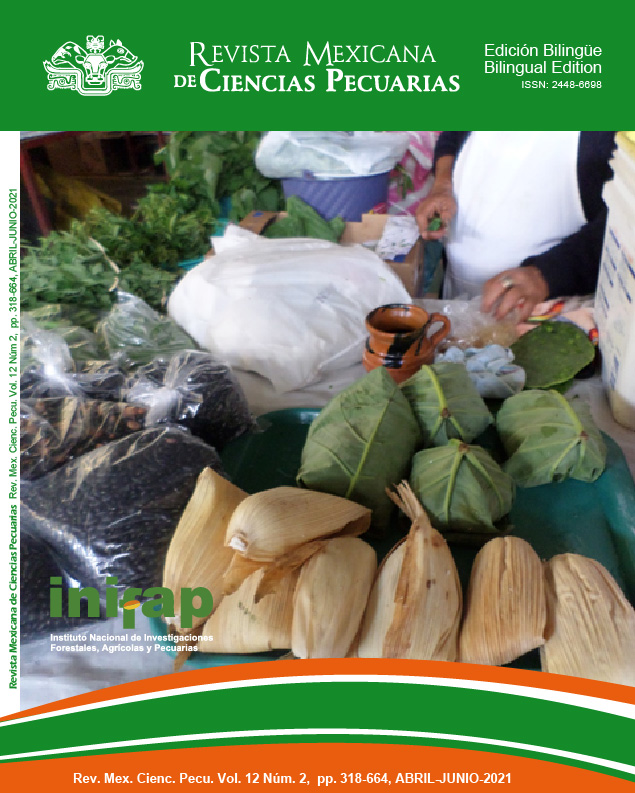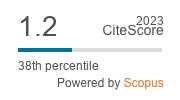Presencia de aflatoxina B1 en alimentos para cabras en unidades de producción de leche caprina del altiplano mexicano
DOI:
https://doi.org/10.22319/rmcp.v12i2.4856Palabras clave:
Aflatoxina B1, Concentrado, Ensilado, HPLC, Cabras lactandoResumen
La presencia de aflatoxinas en el ensilaje y en granos que se destinan para la alimentación de los rumiantes en lactación representa un problema para la salud animal y la inocuidad de la leche. El objetivo del presente trabajo fue determinar el contenido de aflatoxina B1 en alimentos consumidos por cabras procedentes de cuatro unidades de producción de leche caprina del altiplano mexicano (APM). Un total de 47 muestras de concentrados y 29 muestras de ensilados procedentes de cuatro unidades de producción de leche caprina del Altiplano Mexicano (APM). Se analizaron 47 muestras de concentrados y 29 muestras de ensilados por Cromatografía de Líquidos de Alta Resolución (HPLC), empleando una columna de fase reversa y detección por fluorescencia previa derivatización de las aflatoxinas. Los resultados mostraron que el 38.29 % y 31.02 % de las muestras de concentrados y ensilados respectivamente presentaron niveles de AFB1 superiores al límite máximo permisible establecido por la Unión Europea (UE) (0.05 µg/kg); mientras el 29.78 % y 10.34 % para concentrados y ensilados respectivamente presentaron valores superiores a los 20 µg/kg propuesto por la norma oficial mexicana. Los resultados obtenidos corroboran la problemática actual de la presencia de aflatoxinas en la alimentación de las cabras lactantes, al poder metabolizarse esta toxina en aflatoxina M1 y afectar la inocuidad de la leche y derivados de encontrarse la misma.
Descargas
Citas
FAO. Food and Agriculture Organization of the United Nations. Sistemas Nacionales de Inocuidad de Alimentos en las Américas y el Caribe: Análisis de la situación actual http://fao.org/docrep/fao/010/j6410s.pdf 20/05/08. Consultado 30 Ago, 2017.
Trujillo J. Lineamientos para el reconocimiento de las buenas prácticas en producción de leche caprina. (2002). Fuente: http://64.233.187.104/search?q=cache:ILqy5ULsQi8J:www.senasica.sagarpa.gob.mx/web/propuestas_web/221204/inocuidad_agroalimentaria/Lineamientos. Consultado 30 Ago, 2017.
Escobar A, Vega S, Gutiérrez R, Coronado M, Díaz G. Aflatoxina M1 en leche y derivados lácteos. Actualidad y Perspectivas en América Latina. Carnilac Ind 2005;20:21-27.
Vega S, León J. Residuos tóxicos en alimentos. Conceptos y métodos. 1.a ed. CDMX, México: UAM-X. 1998.
Bolet M, Socarrás M. Micotoxinas y cáncer. Rev Cubana Invest Bioméd 2005;24:54-59.
Gimeno A, Martinez M. Residuos de Aflatoxina M1 y otras micotoxinas en leche y derivados, control y recomendaciones http://www.engormix.com 20/05/08. 2001. Consultado 14 Jul, 2017.
Noa M, Pérez N, Gutiérrez R, Escobar A. Los residuos químicos en la leche: importancia y problemática actual en México y en el mundo. 1.a ed. México, DF, UAM-X; 2001:192.
Esqueda M, Higuera I, Nieblas J. Aflatoxina M1 en leche comercializada en Hermosillo, Sonora, México. Rev Mex Mic 1995;11:179-183.
Helferich W. Aflatoxin in food producing animals: metabolism and transmission. Dissertation Abstr Internat 1984;44:3583-3605.
Mashaly R, El-Deeb S, El-Nouty F, Hassan G, Salem M. Effect of feeding aflatoxins to Egyptian Baladi goats on milk yield, composition and physical properties. Egypt J Dairy Sci 1984;12:135-144.
Acosta A, Escobar A, Margolles E, Mella C. Dinámica de excreción de aflatoxina M1 en leche de cabras. Rev Salud Anim 1989;11:208-211.
Bento H, Fernandes A, Barbosa M. Detection of aflatoxin M1 in goat milk [abstract]. XXIII International Dairy Congress. Montreal. Quebec. 1990:26.
Barrios M, Gualda M, Cabanas J, Medina LM, Jordano R. Occurrence of aflatoxin M1 in cheeses from the south of Spain. J Food Protect 1996;59:898-900.
Finoli C, Vecchio A. Aflatoxin M1 in goat dairy products. Mic Aliment Nut 1997;15:47-52.
Minervini F, Visconti A, Bottalico A, Montagna M. On the occurrence of aflatoxin M1 in cheeses in some southern Italian areas. Ind Aliment-Italy 2001;40:513-516.
Battacone G, Nudda A, Palomba M, Pulina G. Carry over of aflatoxin from feed to ovine milk and curd. Scienza e Tecnica Lattiero-Casearia 2002;53:283-293.
Virdis S, Corgiolu G, Scarano C, Pilo A, De Santis E. Occurrence of aflatoxin M1 in tank bulk goat milk and ripened goat cheese. Food Control 2008;19:44-49.
Oliveira C, Ferraz J. Occurrence of aflatoxin M1 in pasteurised, UHT milk and milk powder from goat origin. Food Control 2007;18:375-378.
Bingol N, Tanritanir P, Dede S, Ceylan E. Influence of aflatoxin present in forages and concentrated feedingstuffs on milk and some serum biochemical parameters in goats. B Vet I Pulawy 2007;51:65-69.
Ozdemir M. Determination of aflatoxin M1 levels in goat milk consumed in Kills province. Ankara Univ. Vet. Fak. 2007;54:99-103.
Anyango G, Mutua F, Kagera I, Andang`O P, Grace D, Lindahl J. A survey of aflatoxin M1 contamination in raw milk produced in urban and peri-urban areas of Kisumu County, Kenya. Infect Ecol Epidemiol 2018;8:1-10.
Kilonzo R, Imungi J, Muiru W, Lamuka P, Kamau Njage P. Household dietary exposure to aflatoxins from maize and maize products in Kenya. Food Addit Contam 2014;31:2055-2062.
Bingol N, Tanritanir P, Dede S, Ceylan E. Influence of aflatoxin present in forages and concentrated feedingstuffs on milk and some serum biochemical parameters in goats. B Vet I Pulawy 2007;51:65-69.
NOM-188-SSA1-2002. Norma Oficial Mexicana. Productos y Servicios. Control de aflatoxinas en cereales para consumo humano y animal. Especificaciones sanitarias. Secretaría de Salud. Diario Oficial de la Federación. 14 de junio de 2000.
AOAC. Oficial methods of analysis. 15th ed. Arlington, VA, USA: Association of Official Analytical Chemists. 1995.
ISO. International Organization for Standardization. Animal feeding stuffs-determination of aflatoxin B1 content of mixed feeding stuffs-method using high-performance liquid chromatography. ISO. 14718:1998.
CENAM. CNM-MRD-PT-030. Métodos analíticos adecuados a su propósito. Guía de Laboratorio para la Validación de Métodos y Temas Relacionados. Centro Nacional de Metrología. Publicación Técnica. Los Cués, Querétaro., México. 2005.
UE. Commission Directive 2003/100/EC. Amending Annex I to Directive 2002/32/EC of the European Parliament and of the Council on undesirable substances in animal feed. European Union. Official Journal of the European Union. Brussels. 2003.
Moss M. Risk assessment for aflatoxins in foodstuffs. Int Biodeter Biodegr 2002;50:137-142.
Misihairabgwi JM, Ezekiel CN, Sulyok M, Shephard GS, Krska R. Mycotoxin contamination of foods in Southern Africa: A 10-year review (2007–2016). Critical Rev Food Sci Nutr 2017;1-16.
Matumba L, Van Poucke C, Njumbe Ediage E, De Saeger, S. Keeping mycotoxins away from the food: Does the existence of regulations have any impact in Africa. Crit Rev Food Sci Nutr 2014;57(8):1584-1592.
Bhat R, Rai V, Karim A. Mycotoxins in food and feed: present status and future concerns. Compr Rev Food Sci Food Saf 2009;9:57-81.
EFSA. Modelización, predicción y cartografía de la aparición de aflatoxinas en los cereales en la UE debido al cambio climático. Informe científico presentado por la Autoridad Europea de Seguridad Alimentaria. 2012. Fuente: https://efsa.onlinelibrary.wiley.com/doi/epdf/10.2903/sp.efsa.2012.EN-223. Consultado 20 ago, 2017.
Pahlow G, Muck R, Driehuis F, Oude Elferink S, Spoelstra S. Microbiology of ensiling. Silage science and technology (Agronomy Series No. 42). Buxton DR, et al editors. Am Soc Agron. Madison, WI. 2003.
Ferrero FS, Prencipe D, Spadaro ML, Gullino L, Cavallarin S, Piano E, Tabacco BG. Increase in aflatoxins due to Aspergillus section Flavi multiplication during the aerobic deterioration of corn silage treated with different bacteria inocula. J Dairy Sci 2019;102(2):1176-1193.
Keller M, Pereyra M, Keller K, Alonso V, Oliveira A, Almeida T, et al. Fungal and mycotoxins contamination in corn silage: Monitoring risk before and after fermentation. J Stored Prod Res 2013;52:42–47.
Alonso A, Pereyra C, Keller L, Dalcero A, Rosa C, Chiacchiera S. Cavaglier L. Fungi and mycotoxins in silage: an overview. J Appl Microbiol 2013;115(3):637-643.
Dimitrieska-Stojković, E, Stojanovska-Dimzoska, B, Ilievska, G, Uzunov, R, Stojković G, Hajrulai-Musliu Z, et al. Assessment of aflatoxin contamination in raw milk and feed in Macedonia during 2013. Food Control 2016;59:201-206.
Sacca E, Boscolo D, Vallati A, Ventura W, Bigarand F, Piasentiera E. Aflatoxin ocurrence in milk and supplied concentrates of goat farms of north-eastern Italy. J Sci Food Agric 2009;89(3):487-493.
Cammilleri G, Graci S, Collura R, Buscemi MD, Vella A, Macaluso A, et al. Aflatoxin M1 in cow, sheep, and donkey milk produced in Sicily, Southern Italy. Mycotoxin Res 2019;35(1):47-53.
Descargas
Publicado
Cómo citar
-
Resumen680
-
PDF519
-
PDF 313
Número
Sección
Licencia
Los autores/as que publiquen en la Revista Mexicana de Ciencias Pecuarias aceptan las siguientes condiciones:
De acuerdo con la legislación de derechos de autor, la Revista Mexicana de Ciencias Pecuarias reconoce y respeta el derecho moral de los autores/as, así como la titularidad del derecho patrimonial, el cual será cedido a la revista para su difusión en acceso abierto.

Esta obra está bajo una Licencia Creative Commons Atribución-NoComercial-CompartirIgual 4.0 Internacional.





